 |
|

|
 |
TABLE of CONTENTS
|
MnDOT makes sure pollinators have a place to call home |
By Joseph Palmersheim
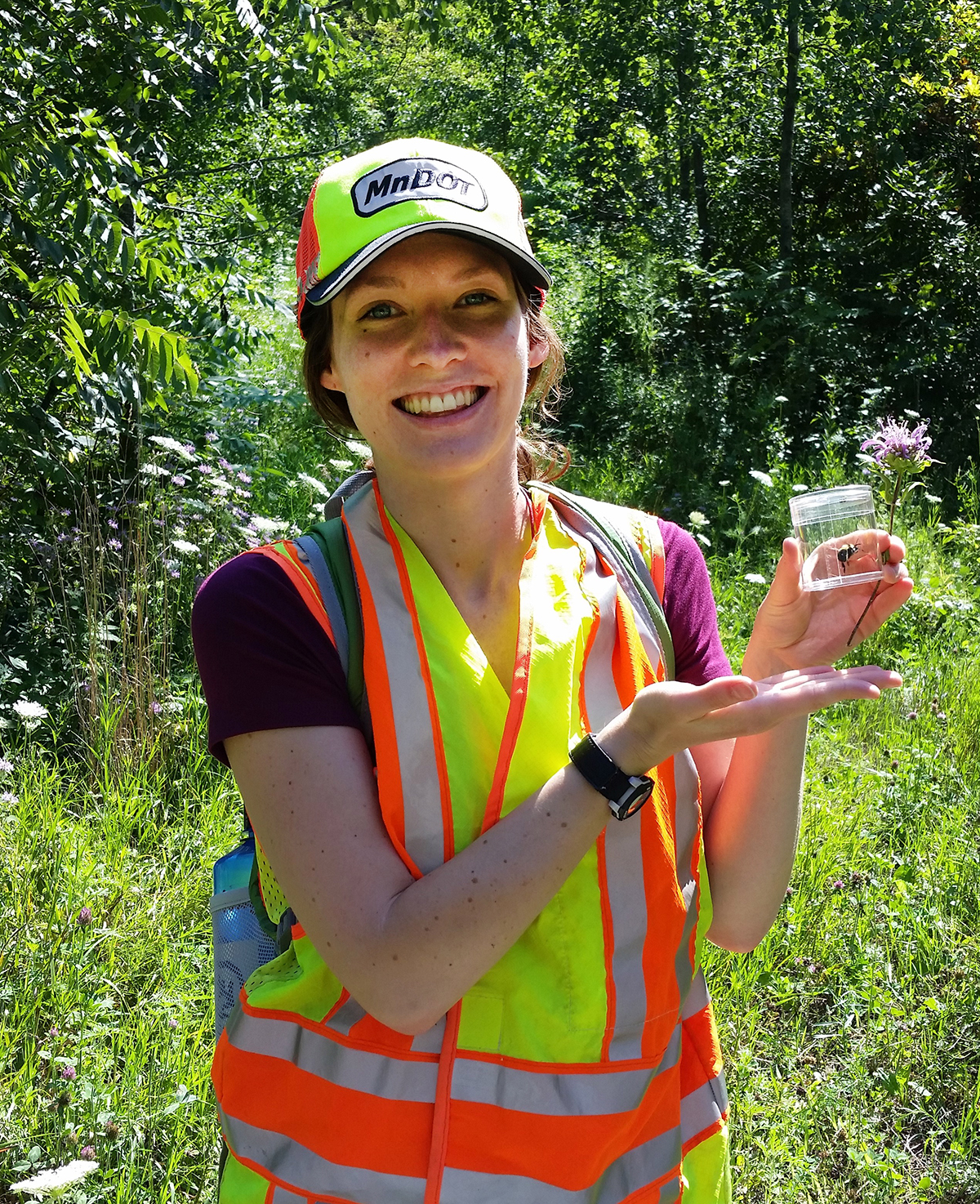
Beth Brown, environmental program specialist, participated in a survey for the endangered rusty-patched bumble bee and found one (her first). She is seen here holding a small container where the bee is temporarily detained for identification purposes and released. Photo by Christopher Smith |
The word “pollinator” perhaps brings to mind the bees, but the term also refers to the butterflies, moths, insects and birds which fertilize one-third of all the food we eat.
With MnDOT managing nearly 175,000 acres of green space in Minnesota, being mindful of pollinators is “part of our efforts to be good stewards of the land,” said Christopher Smith, protected species program coordinator.
“It’s about making sure that wildlife, including pollinators, have a habitat,” Smith said.
One such project involves the rusty-patched bumble bee, which was recently named as the state bee of Minnesota. The Twin Cities metro area is one of a few areas this federally endangered species can still be found, Smith said. They were the focus of a soon-to-be completed University of Minnesota study of how bumble bees use roadside areas.
“We still have a population of rusty-patched bumble bees to study, unlike a lot of places,” Smith said.
Sometimes, the work focuses on the plants the pollinators partner with. Prescribed burns make it easier for native plants to compete with invasive species. Native seed mixes are used in project areas to benefit both pollinating insects and the transportation infrastructure. The deep roots of native plants can help stabilize soil and prevent erosion, he said.
Not all of the work is done alone. MnDOT is one of several members of the Interagency Pollinator Protection Team. The agency stems from an executive order calling for state agency experts to restore pollinator health in Minnesota. Other agencies involved include the departments of Administration, Agriculture, Corrections, Education, Health and Natural Resources; the Minnesota Board of Water and Soil Resources; the Minnesota Pollution Control Agency; and the Minnesota Zoo.
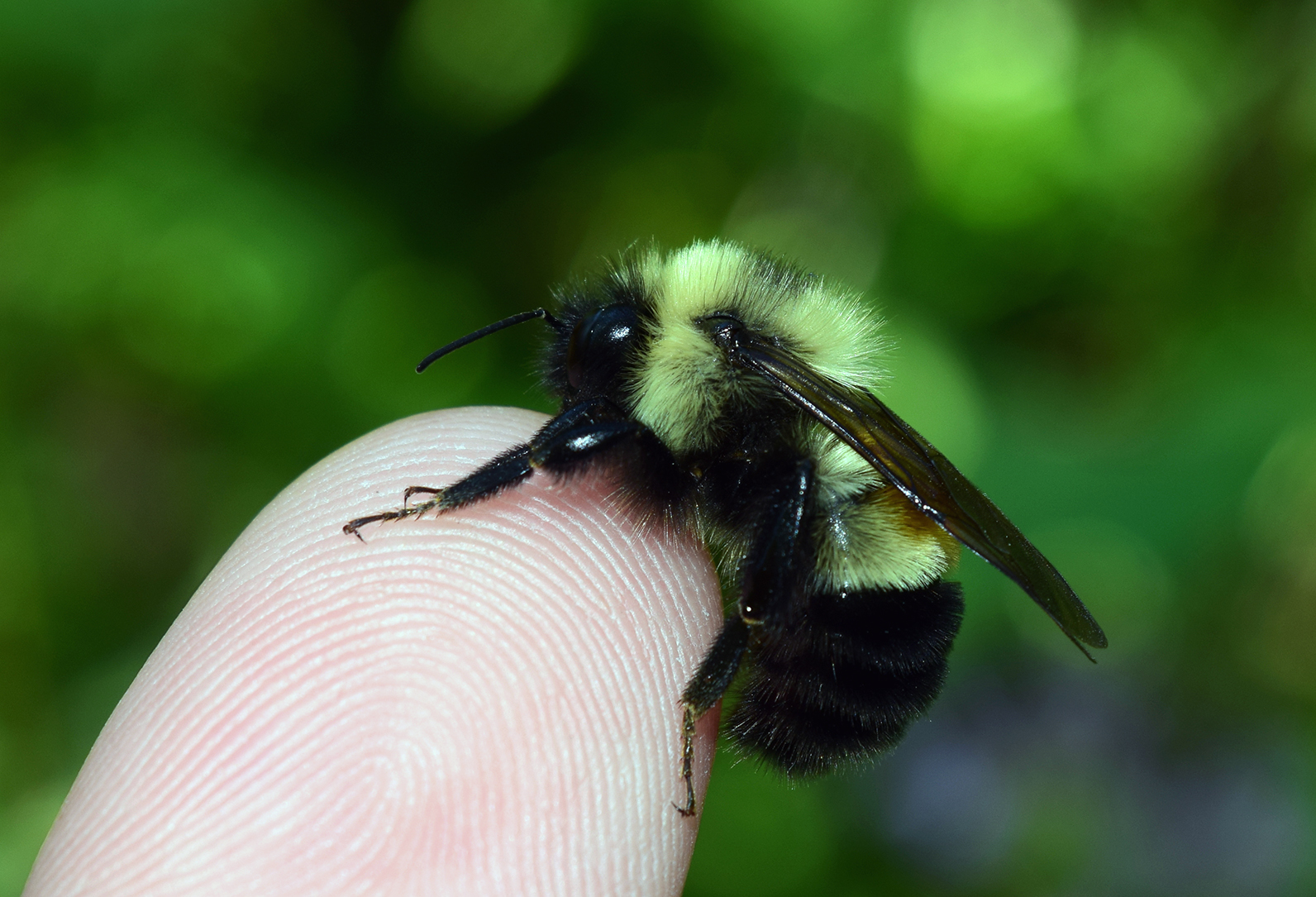
A male rusty-patched bumble bee. Unlike females, males do not sting. Photo by Christoper Smith |
Another partnership involves working with the state DOTs and energy companies along the migratory paths monarch butterflies take each year. The butterfly populations travel more than 3,000 miles to reach Mexico. MnDOT is one of the organizations involved with the Candidate Conservation Agreement with Assurances to encourage non-federal landowners and land managers to adopt measures creating conservation benefits for the monarch butterfly.
“The monarch butterfly is in decline, and it being listed under the federal Endangered Species Act would significantly impact our operations,” Smith said. “There are a lot of regulatory requirements with having an endangered species in roadsides. This is a good example of MnDOT trying to be proactive, maintaining and enhancing habitat for monarchs and other pollinators to recover them before listing is needed.”
In the end, our world would be a different place without pollinators, Smith said.
“We need pollinators for our food, and from an environmental standpoint, a majority of plants require insect pollinators,” he said. “A lot of people enjoy going hiking and enjoying our beautiful forests. Our landscapes wouldn’t look anything like they do today without pollinators.”
More info: dot.state.mn.us/pollinators/
|
 |
|

|
 |
TABLE of CONTENTS
 |
Hwy 65 projects to smooth out ride, drainage issues |
By Beth Petrowske, District 1 public affairs coordinator
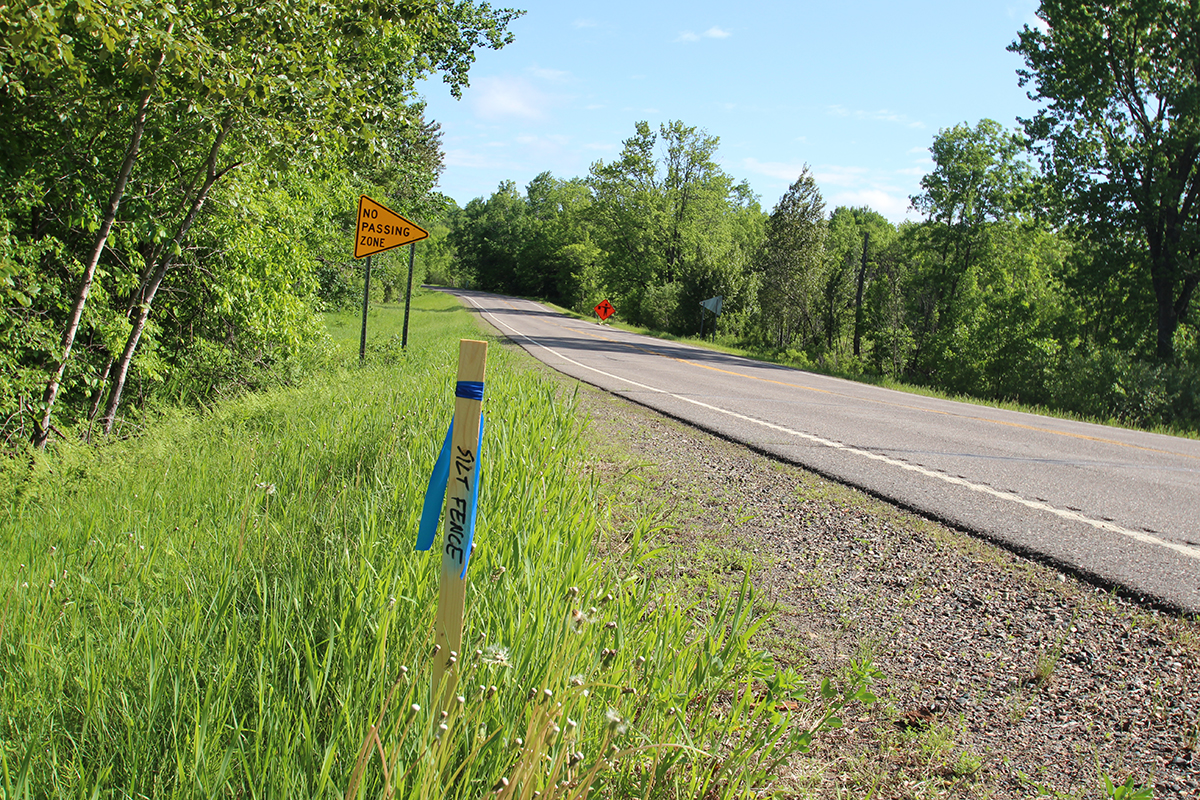
District 1 crews are currently removing trees cut earlier this year along Hwy 65. They are also marking the areas where the new culverts will be placed and installing silt fencing to prevent erosion. Photo by Beth Petrowske |
Three projects on Hwy 65 in Aitkin and Itasca counties will resurface nearly 43 miles of pavement by fall 2019. Costing slightly more than $14 million, these projects will provide a smoother ride, improved drainage and better accessibility at the Big Sandy Lake Overlook just north of McGregor.
“The pavement on Hwy 65 in the project areas is very poor,” said Kevin Bissonette, District 1 supervisor for the projects north of Hwy 200. “The new pavement will give motorists a smoother ride and will also improve safety. We’re also adding rumble strips and improving the shoulders.”
Northern long-eared bats, a threatened species, have been documented roosting in trees near the project areas. All required precautions were followed to ensure the bats were protected. Bissonette said all tree cutting was done prior to March 31. The timing was important, noted Christopher Smith, MnDOT wildlife ecologist.
“The bats begin moving out of their winter hibernation locations and into the trees to rear their young in April,” Smith said. “It’s important we don’t increase the chance of bat mortality by disturbing the maternity roosting process.”
According to Smith, northern long-eared bats only have one pup each year.
Geogrid, a geosynthetic material used to reinforce soils and similar materials, will be used in part of the project south of Hwy 200. Andrew Dostal, the District 1 supervisor for the Hwy 65 project south of Hwy 200, is interested to see how this product will perform in the long term.
“There are poor subgrade soils in the reconstruct section,” Dostal said. “We’ll remove all the pavement and another foot of material, then we’ll place new aggregate base with a layer of geogrid to stabilize the subgrade. This has potential to be a cost-effective, long-term solution to a problem we encounter often in District 1.”
Project locations:
|
 |
|

|
 |
TABLE of CONTENTS
 |
Training pairs MnDOT, White Earth Nation |
|
By Adrien Carretero, Office of Government Affairs, and Mindy Heinkel, Maintenance OPS Research
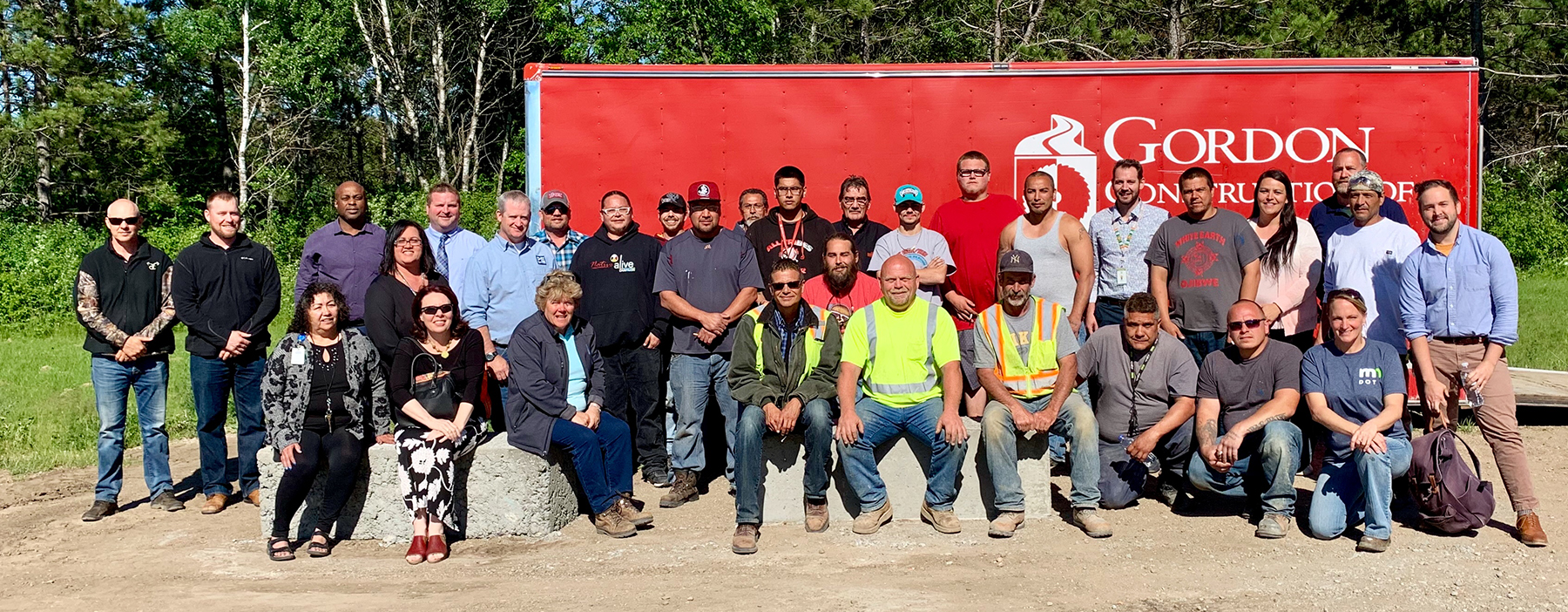
MnDOT staff and members of the White Earth Nation recently partnered for ADA hands-on construction training at the Maadaadizi Workforce Center in Mahnomen. Photo courtesy of Gordon Construction |
White Earth Nation and MnDOT recently held the first hands-on ADA construction training in Indian Country.
Fifteen participants graduated June 12 after the three-day training at the Maadaadizi Workforce Center in Mahnomen. Graduates are enrolled tribal members. The training equipped them with the skills and knowledge to work on MnDOT projects on the White Earth Reservation and across the state. MnDOT Tribal Affairs coordinated this partnership with White Earth Nation.
“We tried to partner on a training with other organizations for nearly three years,” said Esther Ames, White Earth Nation tribal employment officer. “We were pleased when MnDOT proposed to collaborate.”
MnDOT’s ADA program team worked with native-owned business Gordon Construction and MnDOT consultant PE Services. MnDOT team members included Richard Haavisto, Dustin Walls and Mindy Heinkel. The training is designed to provide employment opportunities to graduates and tackle the large contracting disparity affecting native-owned businesses.
During the graduation ceremony, White Earth Nation Acting Chairman Eugene “Umsy” Tibbetts and District 4 Engineer Shiloh Wahl gave each graduate a MnDOT Construction Specification book and a signed certificate. |
 |
|

|
 |
TABLE of CONTENTS
 |
Southwest Light Rail Transit on track to connect the Twin Cities |
By Mary McFarland Brooks

The initial piling work for construction of Eden Prairie Southwest station has started. The station will also house park and ride spots and Southwest Transit Bus Service. From left are Transit Section employees Amrish Patel, Bob Winter and Carolyn Fackler. Photo by RIch Kemp |
The Metro Green Line Extension, commonly known as the Southwest Light Rail Transit project, is a 14.5-mile extension of the Central Corridor LRT. The project began construction in May 2019. It extends from downtown Minneapolis through the communities of St. Louis Park, Hopkins, Minnetonka and Eden Prairie.
The SLRT corridor will include 16 new stations:
- Eden Prairie: SouthWest Station, Town Center Station, Golden Triangle, City West
- Minnetonka: Opus Station
- Hopkins: Shady Oak, Downtown Hopkins, Blake Road
- St. Louis Park: Louisiana Avenue, Wooddale Avenue, Beltline Boulevard
- Minneapolis: West Lake Street, West 21st Street, Bryn Mawr, Bassett Creek Valley, Royalston Avenue/Farmers Market
Eight park and rides will offer approximately 2,700 new parking spaces. These feature passenger drop-off areas, along with bicycle and pedestrian access. New or restructured local bus routes connect these stations to nearby residential, commercial and educational destinations.
The SLRT project began in earnest in August 2010 when the Metropolitan Council applied to the Federal Transit Administration for approval to enter preliminary engineering. The Federal Transit Administration granted project approval in November 2018, allowing construction to begin. The project is expected to apply for its full funding grant agreement later this year. This would commit the federal government to pay 46 percent of the project’s capital cost. Service is anticipated to start in 2023.
MnDOT is involved with SWLRT through the Metro District Transit Section under the lead of Ryan Wilson, section director. This MnDOT team also works with other agency offices on the project.
“MnDOT staff are embedded in the project office and work cooperatively with public and private sector staff,” Wilson said. “Their duties are valued by our partners and are critical to the success of the project.”
The SWLRT project budget is approximately $2 billion. Funding comes from the Federal Transit Administration, Hennepin County, Hennepin County Railroad Authority, Counties Transit Improvement Board, the state of Minnesota and other local funding partners.
MnDOT employees working fulltime on the project from the Transit Section include Matt Aguirre, Jim DeLuca, Carolyn Fackler, Joe Nietfeld, Amrish Patel, Doug Stahl, Ramu Titiraju, Luke Van Santen, Mike Vogel, Ryan Wilson and Bill Winter. MnDOT Environmental Stewardship employees Greg Mathis and Jeff Neisse also contribute. These employees provide a variety of professional technical services from the environmental phase through construction. They are also responsible for right of way acquisition, structural review, permits, environmental mitigation, project document management system administration, and various aspects of construction management and inspection.
Along with SWLRT, MnDOT staff also support all transitways in the Twin Cities, including:
- Green Line Extension LRT
- Blue Line Extension LRT
- Gold Line Bus Rapid Transit
- Rush Line Bus Rapid Transit
- Riverview Corridor
“The SWLRT line is an important component of the regional transit system and will serve as a one-seat ride from Eden Prairie to downtown St. Paul, connecting major activity centers, housing and employers in the region,” said Trevor Roy, SWLRT senior communications specialist.
A virtual flyover tour, local station visualizations and general information are available on the Met Council’s website.
|
 |
|

|
 |
TABLE of CONTENTS
 |
Charging ahead with electric, hybrid vehicles |
By Joseph Palmersheim
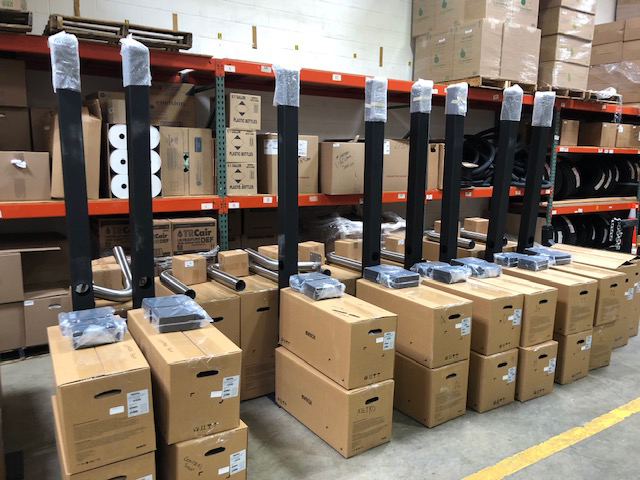
These electric vehicle charging stations were delivered to the Central Shop the week of June 5. They will be set up across the state as MnDOT adds more electric and hybrid vehicles to the fleet. Photo by Tim Sexton |
MnDOT is plugging into the future of driving.
The agency is in the process of installing 28 electric vehicle chargers while adding 16 new fully electric and plug-in hybrids to the fleet.
Once the chargers are installed, each district will have at least one, and some districts will have up to four. Prior to this, the only MnDOT-owned EV charger was located at Water’s Edge in Roseville.
The new vehicles are Chevy Bolts and Mitsubishi Outlander PHEVs. The Outlanders run on battery power for about 25 miles before a gasoline engine kicks in. The Bolt is fully electric and can go about 240 miles between charges.
The EV chargers will serve a few different audiences. Some chargers will be located with the shared/pooled vehicles and others will be in the front of MnDOT buildings. The chargers in front will be available for use by the public and MnDOT employees.
“This is part of a broader statewide effort to reduce our fuel consumption and emissions,” said Tim Sexton, chief sustainability officer. “In addition to making progress towards our state and agency climate goals, these vehicles also cost much less to operate and maintain than a gasoline-powered vehicle. For example, a Chevy Bolt costs about 15 percent of what it costs to operate and maintain a similar gas-powered car.”
Electric vehicles are very different under the hood as well. There are no oil or spark plugs to change, no air filter, no coolant – and no engine. Instead, each wheel is powered by a small electric motor. About the only things that need changing, Sexton said, are windshield wiper fluid and brakes, and even brakes are changed less frequently.
Sexton doesn’t see the technology going away anytime soon.
“All signs point to this as being just the beginning,” he said. “All the big car and heavy duty truck companies are making big investments in EVs, including plans for electric pickup trucks by late 2020.”
The performance of these EVs and chargers will be evaluated as the program progresses and technology changes, Sexton said. This includes finding the best location for new chargers and identifying which EVs are best suited for MnDOT. The new charging stations will be installed throughout the summer.
Some of the districts are already rolling with the new changes. For example, District 6 received two Outlanders and a Bolt. Mark Panek, assistant district engineer west operations, said two of the vehicles will be in the Rochester motor pool and used as pool cars for district business. One Outlander will be assigned to a construction employee in the Owatonna office and used for project duties. It’s important to keep up with a fast-changing technology, he said.
“This provides our district the opportunity to explore the opportunities and avenues these vehicles could provide,” Panek said. “The potential fuel savings when they can make an electric car or pickup with a 400-mile range is what we would desire in the district someday.”
|
 |
|

|
 |
TABLE of CONTENTS
 |
Leadership Development Program open enrollment starts June 24 |
|
By Shawn Meade, Office of Human Resources
Leadership Development Program open enrollment starts June 24 and ends July 26.
Open to all employees, this unique program allows employees to work on their core competencies and attend learning opportunities that fit their work schedule. More than 1,300 employees have participated since LDP started in 2012.
The 2019-2020 Leadership Development Program is structured with two groups starting at different times during the program year. Group 13 will start Sept. 3, and Group 14 will start March 2, 2020. Employees can enroll in either group during the enrollment period, which starts June 24. A second enrollment period for Group 14 is scheduled for December.
To learn more about the Leadership Development Program, visit the LDP website or attend a Skype information session (see dates below). Email shawn.meade@state.mn.us to register for an information session.
Leadership Development Program – optional Skype information sessions
- June 26 – 1-1:30 p.m.
- June 27 – 9-9:30 a.m.
- July 9 – 10-10:30 a.m.
- July 10 – 2-2:30 p.m.
- July 18 – 3-3:30 p.m.
|
 |
|

|
 |
TABLE of CONTENTS
 |
New library materials posted on the web |
New library materials are now available. This issue highlights new titles in leadership.
New Library Materials is a compilation of new titles and other resources added to the library collection during the previous month. If you would like to be added to the distribution list or have any questions, email library.dot@state.mn.us or send requests via the Ask a Librarian webpage.
|
 |
|

|
 |
TABLE of CONTENTS
 |
District 6 wins shared drive reduction initiative |
By Charles Stech, Office of Chief Counsel

District 6 employees celebrated the Golden Hard Drive win with ice cream treats during afternoon break time. The district deleted more than 150,000 files in the cleanup effort. Photo by Mike Dougherty |
District 6 is the winner of this year’s Golden Hard Drive Award.
The district reduced its shared drive by 8.62 percent, with almost 150,000 files deleted. The Commissioner’s Office was the largest reducer among offices, with 5.17 percent. Honorable mention goes to the Office of Finance, which deleted more than 3.48 percent.
Employees were asked to dedicate four hours in May to review their office’s shared drive and delete outdated redundant, obsolete, trivial electronic files at the end of their retention period.
Storage reduction has been an ongoing coordinated effort between the District Management Team and the District Leadership Team, said Judy Evers, District 6 executive assistant. Reports from MNIT were used to determine proper storage location and to reduce duplicate files.
The Golden Hard Drive Award also sparked others in District 6 to talk about how to continue the efforts in reducing storage space, not just during the month designated.
“Thank you to everyone who helped out in our effort to reduce the excessive amount of electronic files,” said Jennifer W. Witt, Records and Information manager. “These efforts will help with increased storage space and reduce cost.”
|
 |
|

|
 |
TABLE of CONTENTS
 |
Pavement workshop features 25 years of MnDOT road research |
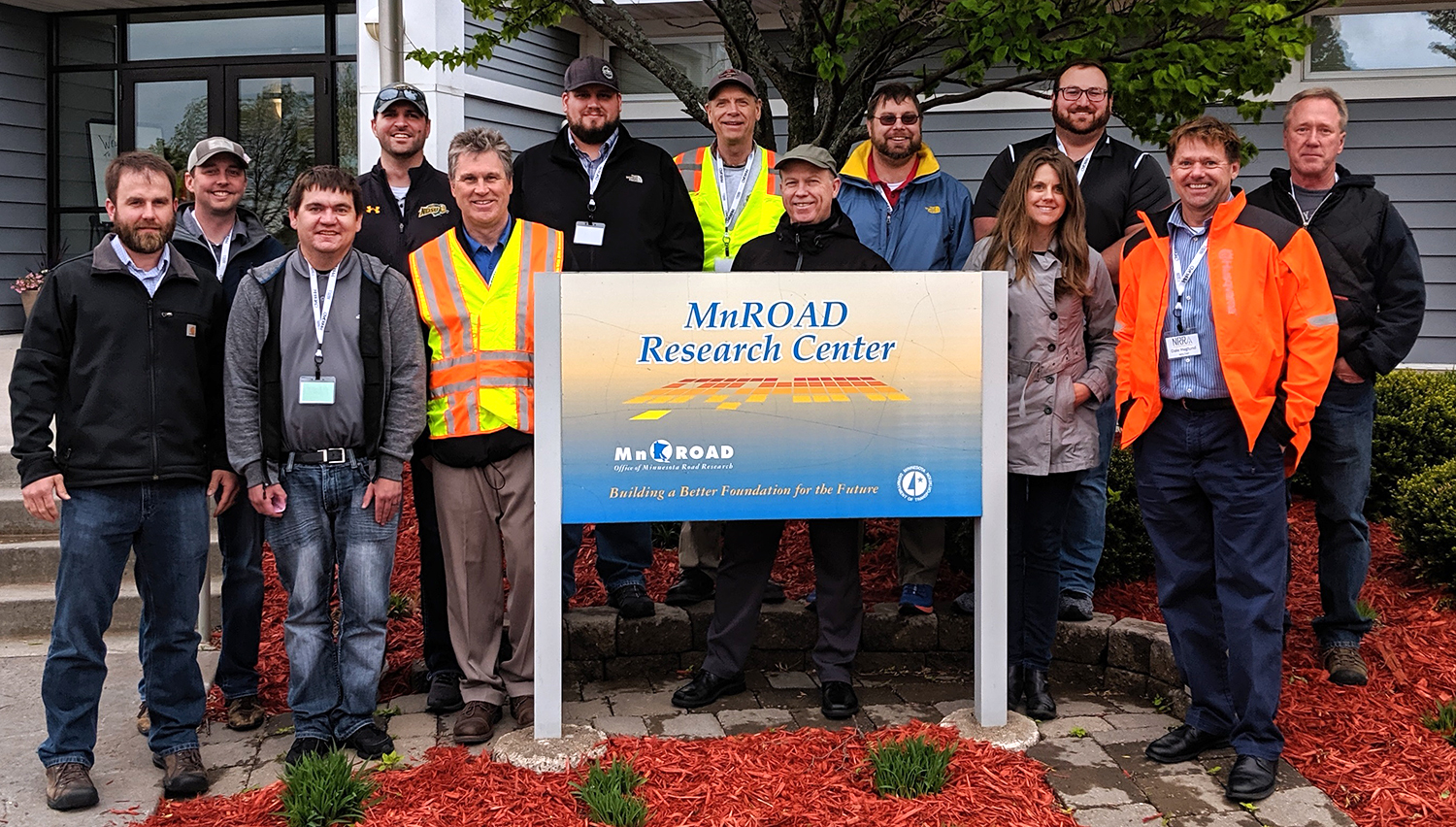
The annual National Road Research Alliance Pavement Workshop met May 21-23 in St. Paul. The MnDOT initiative funds and guides pavement research at MnROAD and across the nation. It is made up of eight state DOTs, the Local Road Research Board and about 55 associate organizations.
Day one focused on building iInformation modeling in road construction. Day two featured an afternoon trip to MnROAD, where attendees could get a tour or see two Federal Highway Administration trailers on site. Day three featured a keynote speech from MnROAD Operations Engineer Ben Worel on a “Quarter Century of MnROAD Advancements.” Photo by Bob Filipczak |
|
 |
|

|
|

|
 |
TABLE of CONTENTS
 |
Gov. Walz signs 'Work Zone Flagger bill' |
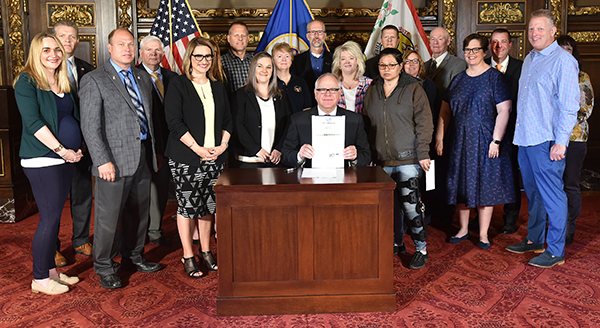
Gov. Tim Walz signed SF 1753, dubbed "the Work Zone Flagger bill," during a ceremony Friday, June 14. This law allows a work zone flagger to report a driver to law enforcement when the driver disobeys the flagger’s directions. Law enforcement has up to four hours after an incident to cite the driver.
Others at the signing included, from left, back row: Tim Worke (Associated General Conractors of Minnesota), Thomas McCrossan (C.S. McCrossan, Inc.), Abbey Bryduck (Minnesota Asphalt Pavement Association), Kent Peterson (Bituminous Roadways, Inc.), Erik Rudeen (MnDOT), Brian Sorenson (MnDOT), Peter Buchen (MnDOT), Kris Fredson (Laborers’ International Union of North America), Sherry Munyon (Capitol Access, Inc.). From left, front row: Laura Ziegler (AGC), Sen. Rarick (bill sponsor), Lt. Gov. Flanagan, Rep. Koegel (bill sponsor), Leigh Kriewall (MnDOT), Jennifer Witt (MnDOT), Laura Berg (flagger injured in a work zone), Commissioner Anderson Kelliher and Jason Duininck (Duininck, Inc.) Photo by Rich Kemp
|
|
 |
|

|
 |
TABLE of CONTENTS
 |
On the Job: District 8 coordinator helps hundreds of volunteers keep roadsides clean |
By Anne Meyer
We caught up with Linda Vandendriessche, an Adopt a Highway coordinator in District 8, and asked her a few questions about her job.
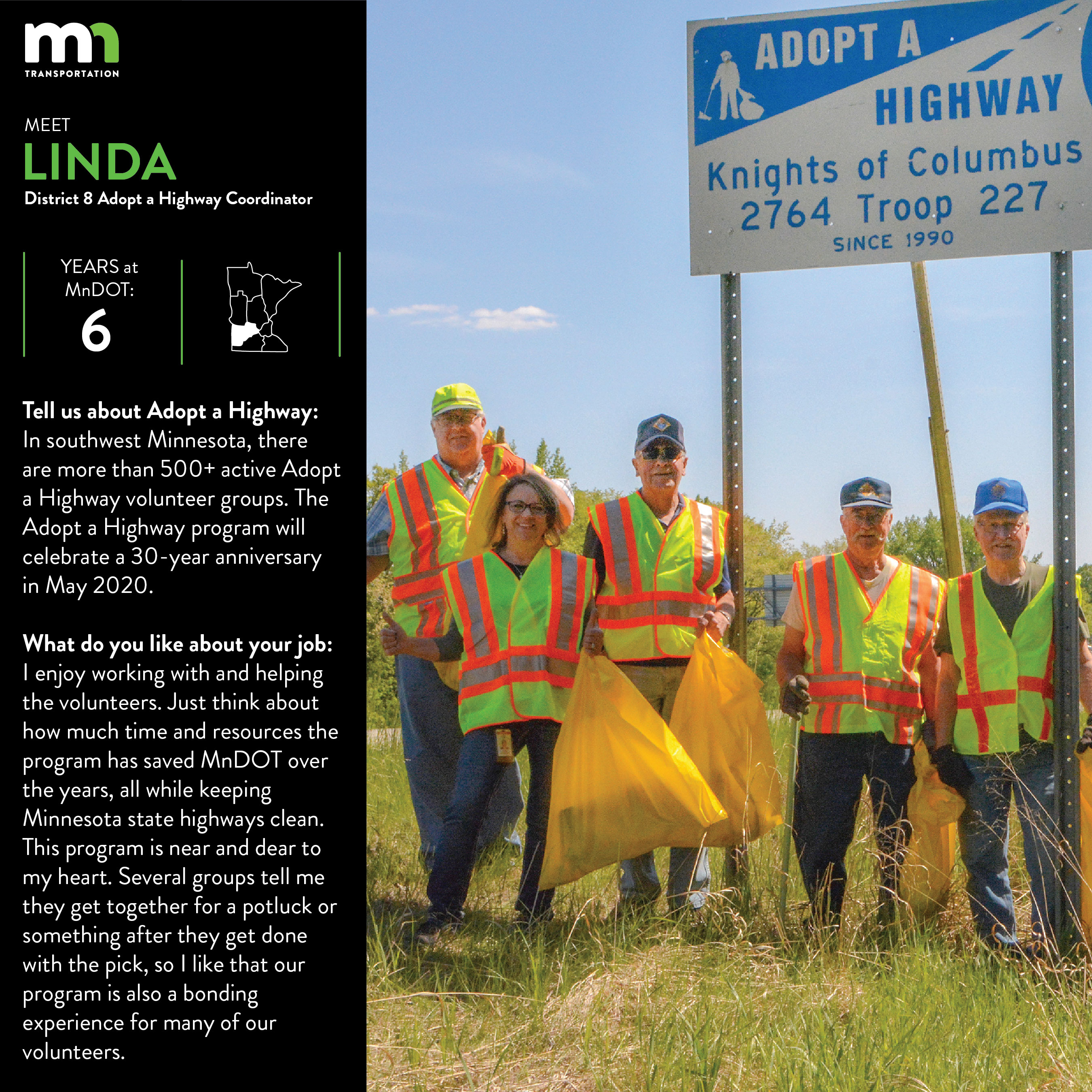
Do you or a co-worker have an interesting job to share with readers? Send us your ideas, and we’ll contact you for more information.
Recent employee profiles:
|
| |
|
| |
|
w



